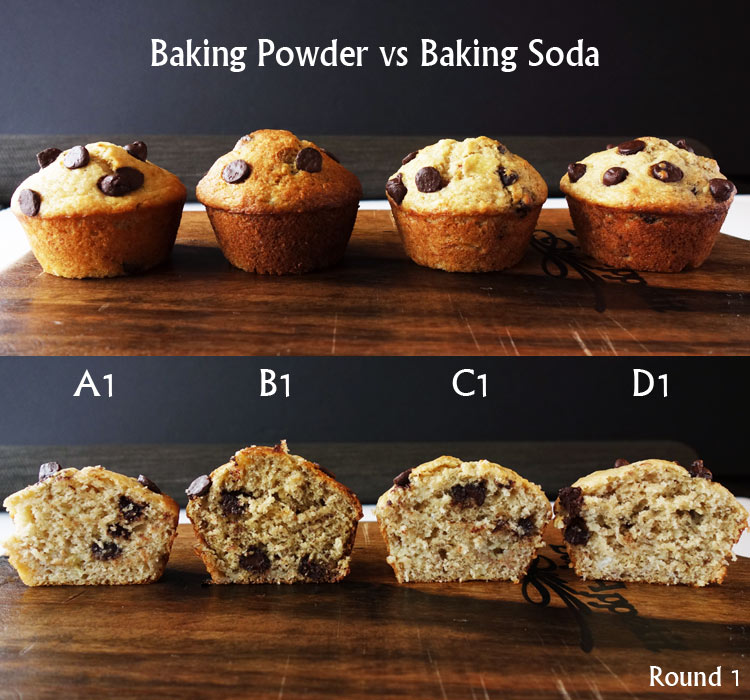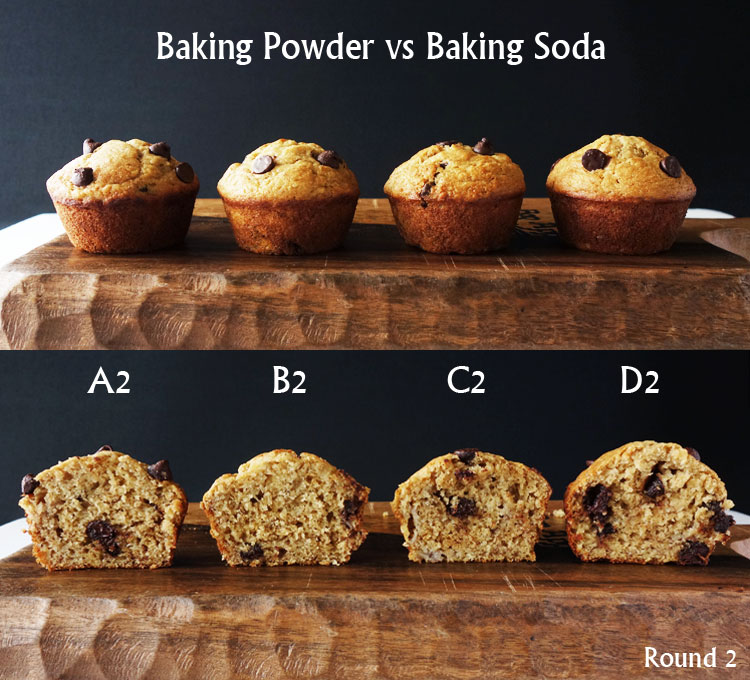Since my mom’s the biggest influence in my cooking ventures, I will attribute my lack of needing to measure to her. It’s her fault basically. Now comes baking. A completely different story, isn’t it. The first 10 yeast breads I baked, well.. let’s just say I became a pro in churning out tons of breadcrumbs. It’s because the ‘lack of measuring’ DNA that I have wired in me. Like I said, my mom’s fault.
When I finally came to terms with the need to measure (obey, Ai Ping, obey…. ohmmm), I faced a different problem. Every recipe has a different amount of baking soda and baking powder. No, not in yeast breads. I’m clueless sometimes but not that clueless. In muffins. How much do they really need? Some has one teaspoon baking powder for every one cup. Others have two teaspoons. So, I decided to see for myself.
Below are two tests. They are both based on this banana muffin recipe with the first test using regular cane sugar and the second using brown sugar.
1st test results:
| A1 | B1 | C1 | D1 | |
|
Baking Powder |
2 tsp | 1 tsp | 1 tsp | 1/2 tsp |
| Baking Soda | – | 1 tsp | 1/2 tsp |
1/2 tsp |
| Color | Light | Dark | Light |
Light |
|
Height |
Shortest |
Slightly taller than the rest |
Slightly shorter than B1 |
|
| Texture |
Dense |
Well-leavened |
A little less leavened than B1 |
|
|
Taste |
A1 and B1 has a slight metallic taste |
|||
Conclusions for 1st test:
1. Even though B1 & C1’s difference is 1/2 tsp baking soda, there is not a substantial difference in height. The little bump on B1 is actually because of an extra small fold present at the top of the batter.
2. B1 is darker in color because of the extra baking soda (which browns food).
3. A1 and B1 has a slight metallic taste. It’s subtle. My guess is due to excess baking soda or baking powder in them.
The second test’s main purpose is to see the difference in the muffins when the amount of baking powder is increased.
2nd test results:
| A2 | B2 | C2 | D2 | |
|
Baking Powder |
1/2 tsp | 1 tsp | 1 1/4 tsp | 1 1/2 tsp |
| Baking Soda | 1/2 tsp | 1/2 tsp | 1/2 tsp |
1/2 tsp |
|
Color |
No obvious difference |
|||
| Height |
A glance shows similar height but if you look super close you can discern the increase in height from A2 to D2 |
|||
|
Texture |
No obvious difference | |||
| Taste |
C2 and D2 has a slight metallic taste |
|||
Conclusions for 2nd test:
1. If you’ve noticed, A2 & B2 has the same baking powder and baking soda as C1 & D1. Between them, there is a difference in color because of the brown sugar in the second test but all four are similarly leavened.
2. There’s a minimal difference in height between A2 and D2.
3. Again, C2 and D2 has a slight metallic taste. It’s very subtle but it’s there. Mr. V couldn’t even tell so I presume you can only tell if you are looking hard for it (which I was).
So, perhaps you have been baking with the amount like D1 or C2. However, it looks like muffins will turn out pretty similar with less baking soda or baking powder. Or perhaps you’ve not putting enough soda or powder and weren’t sure how much to increase. Well now you do. I hope this test helps you draw your own conclusions about how much baking powder and baking soda you want in your muffins (and quick breads).
My take from this test:
I’ve always baked muffins and quick bread with ‘B1’. But it has always turned too dark too soon. Now I know how to lighten the color without decreasing the leavening effect. Below are my conclusions.
a. For every 2 cups of flour, 2 tsp baking powder is required.
b. For every 1/2 cup ‘decorative’ added, in my case chocolate chips, 1/2 tsp baking powder is required.
c. For every 2 cups of flour that has acidic ingredients (eg. brown sugar/yogurt), 1/2 tsp baking soda is required.
So total baking powder required = 2 1/2 tsp (2 + 1/2). Total baking soda required = 1/2 tsp.
Problem: If I add 1/2 tsp baking soda, I have to take out 2 tsp baking powder (since baking soda is 4 times stronger than baking powder).
So all I need is 1/2 tsp baking soda and 1/2 tsp baking powder (2 1/2 minus 2).
This theory brings us to D1 or A2. However, for me, D1 is way too light in color while A2 shows a better color just because of the use of brown sugar. A2 would be my choice in making muffins and if I want a slight increase in height, B2 is good too. I really don’t care much for the slight height increase an extra 1/4 or 1/2 tsp baking powder may be able to bring especially if there’s a possibility of an ever so slight metallic taste in them. So in conclusion, my muffins will be made with 1/2 tsp baking soda (with brown sugar) and 1/2 – 1 tsp baking powder.
My last post: Banana Chocolate Chip Muffins
Have you performed your own baking soda and baking powder test? What was the outcome?



6 comments
Excellent research. Very helpful. Thank you!
Excellent article! I have a delicious blueberry muffin recipe that is sweet, even without the added sugar. I made a new batch, leaving out the sugar for my diabetic friend, who is looking for a way to enjoy a sweet treat now and then. The sugarless muffins came out plenty sweet, but heavy and damp. Turns out sugar is a leavening agent, and also helps mop up the moisture from the (frozen) blueberries. After reading your article I will try again with an extra 1/2 tsp of baking soda. (I’ll also try fresh blueberries when they come into season, as they won’t spill their juices as much as frozen.)
Hi. Amazing article. Great effort
Hi! Just came across this article while researching how to make my own muffin recipe. This is very helpful work you did! Thanks!
Very informative. Appreciated.
Hope you found them helpful. 🙂